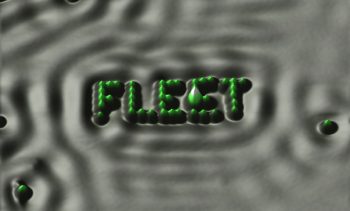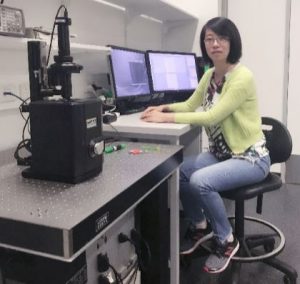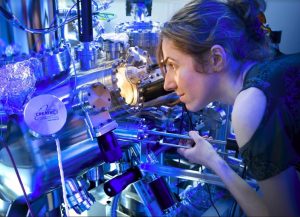FLEET researchers taking an innovative, even ‘playful’, approach to their science have created a couple of unique and interesting branding displays for the Centre.
 >>>FLEET PhD student Fan Ji developed this micro-sized logo (right) at UNSW. The FLEET logo is etched onto the two-dimensional interface between two materials, in letters only a few thousandths of a millimetre high, using bias-assisted atomic force microscopy (AFM) lithography.
>>>FLEET PhD student Fan Ji developed this micro-sized logo (right) at UNSW. The FLEET logo is etched onto the two-dimensional interface between two materials, in letters only a few thousandths of a millimetre high, using bias-assisted atomic force microscopy (AFM) lithography.
 <<<At Monash University, FLEET affiliate Marina Castelli used the tip of a scanning tunnelling microscope (STM) to manipulate individual iron atoms on a silver surface, creating this nano-scale logo (left) comprising just 42 atoms.
<<<At Monash University, FLEET affiliate Marina Castelli used the tip of a scanning tunnelling microscope (STM) to manipulate individual iron atoms on a silver surface, creating this nano-scale logo (left) comprising just 42 atoms.
Atomic force microscopy (AFM) lithography is a technique used in FLEET’s UNSW labs to study (AFM) and to ‘mill’ (lithography) materials at microscopic scales. Using the extremely sharp tip of the atomic force microscope, surface features can not only be observed, but also be manipulated: adding and subtracting material as required, at an incredibly precise scale. Fan Ji works with FLEET’s Jan Seidel, part of FLEET’s Enabling Technology Theme B, nanodevice fabrication. The AFM lithographic technique can be used to integrate electrical units into topological materials at the nanoscale. The dimensions of the UNSW lithographic brand are approx. 19 micrometres long by 7 micrometres high. (A micrometre is one thousandth of a millimetre, so you could fit more than fifty logos across the width of a fullstop.)
At Monash University, Marina Castelli uses the sharp tip of a scanning tunnelling microscope to manipulate individual atoms iron atoms into place, on a silver substrate. This technique is used to understand the structure of specific nanostructures, and to study their electronic properties. The logo shown is 40 nanometres long by 25 nanometres high (A nanometre is a millionth of a millimetre, but the important thing here is that each dot is an individual iron atom, so this is mindsnappingly small). The slightly brighter atom in the middle of the 2nd ‘E’, is actually an accident: a small ‘tip crash’ of the AFM instrument: “I was trying to push two iron atoms next to each other….luckily it did not destroy the other letters!”, says Marina, who works with FLEET’s Agustin Schiffrin.
FLEET’s research sits at the very boundary of what is possible in condensed-matter physics. At the nano scale, nanofabrication of functioning devices will be key to the Centre’s success. Specialised techniques are needed to integrate novel atomically-thin, two-dimensional (2D) materials into high-quality, high-performance nano-devices. This research is grouped under the Centre’s Enabling Technology B, nanodevice fabrication, led by Lan Wang at RMIT.



